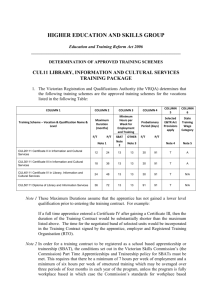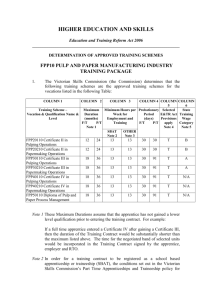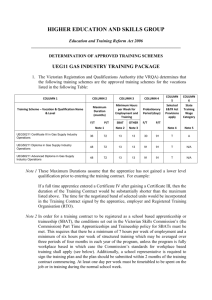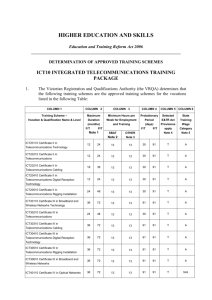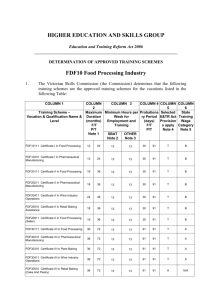Hairdressing | Approved Training Schemes
advertisement
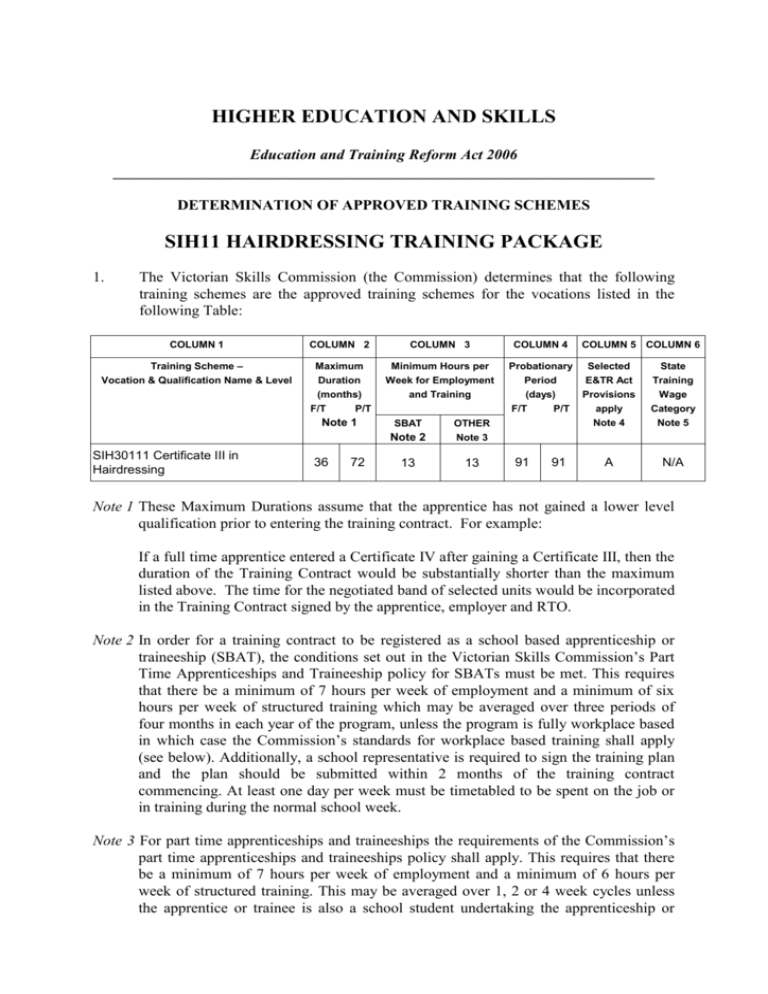
HIGHER EDUCATION AND SKILLS Education and Training Reform Act 2006 ______________________________________________________________________ DETERMINATION OF APPROVED TRAINING SCHEMES SIH11 HAIRDRESSING TRAINING PACKAGE 1. The Victorian Skills Commission (the Commission) determines that the following training schemes are the approved training schemes for the vocations listed in the following Table: COLUMN 1 COLUMN 2 COLUMN 3 Training Scheme – Vocation & Qualification Name & Level Maximum Duration (months) F/T P/T Minimum Hours per Week for Employment and Training Note 1 SIH30111 Certificate III in Hairdressing 36 72 Note 2 SBAT OTHER Note 3 13 13 COLUMN 4 COLUMN 5 COLUMN 6 Probationary Selected Period E&TR Act (days) Provisions F/T P/T apply Note 4 91 91 A State Training Wage Category Note 5 N/A Note 1 These Maximum Durations assume that the apprentice has not gained a lower level qualification prior to entering the training contract. For example: If a full time apprentice entered a Certificate IV after gaining a Certificate III, then the duration of the Training Contract would be substantially shorter than the maximum listed above. The time for the negotiated band of selected units would be incorporated in the Training Contract signed by the apprentice, employer and RTO. Note 2 In order for a training contract to be registered as a school based apprenticeship or traineeship (SBAT), the conditions set out in the Victorian Skills Commission’s Part Time Apprenticeships and Traineeship policy for SBATs must be met. This requires that there be a minimum of 7 hours per week of employment and a minimum of six hours per week of structured training which may be averaged over three periods of four months in each year of the program, unless the program is fully workplace based in which case the Commission’s standards for workplace based training shall apply (see below). Additionally, a school representative is required to sign the training plan and the plan should be submitted within 2 months of the training contract commencing. At least one day per week must be timetabled to be spent on the job or in training during the normal school week. Note 3 For part time apprenticeships and traineeships the requirements of the Commission’s part time apprenticeships and traineeships policy shall apply. This requires that there be a minimum of 7 hours per week of employment and a minimum of 6 hours per week of structured training. This may be averaged over 1, 2 or 4 week cycles unless the apprentice or trainee is also a school student undertaking the apprenticeship or traineeship outside school hours in which case it may be averaged over three periods of four months in each year of the program. However if the training program is fully workplace based, the Commission’s standards for workplace based training shall apply (see below). Note 4 For Apprenticeship vocations (A) sections 5.5.15(1), 5.5.16(2), (3) and(4), 5.5.17(1)(d) and 5.5.19 of the Education and Training Reform Act 2006 apply. For Traineeship vocations (T) these sections do not apply. Note 5 Trainees undertaking a Certificate IV traineeship shall receive the relevant weekly wage rate for Certificate III trainees at Wage levels A, B or C as applicable with the addition of 3.8 per cent of that wage rate. Standards for ‘Workplace Based Training’ The minimum hours of employment are 13 hours per week. All apprentices/trainees undertaking workplace training at Certificates I or II must be withdrawn from routine work duties for a minimum of 1.5 hours per week (pro rata for part time apprentices/trainees with a minimum of one half hour), averaged over a two month cycle for the purpose of undertaking structured training/learning activities. This release must occur periodically. Where the qualification is at Certificate III or above, apprentices/trainees must be withdrawn from routine work duties for a minimum of three hours per week (pro rata for part time apprentices/trainees with a minimum of one hour) for planned training, averaged over a four week cycle. The training undertaken during the period of release must include a focus on the compliance and regulatory units and the units concentrating on generic skills. Up to 40 hours of this training may be transferred, to be delivered in one or more blocks during the first three months of the training program. In the Table COLUMN 1 - specifies the relevant vocation and level of qualification, under the Australian Qualifications Framework, that will be issued on successful completion of the Approved Training Scheme. COLUMN 2 - specifies the maximum duration of the Approved Training Scheme for each relevant qualification on a full-time, and where available, a part-time basis. COLUMN 3 - specifies the minimum average number of hours of employment and training required under the training contract and references the Commission’s policy on part time apprenticeships and traineeships including School Based Apprenticeships and Traineeships. COLUMN 4 - specifies any applicable probationary period. COLUMN 5 - specifies whether sections 5.5.15(1), 5.5.16(2), (3) and (4), 5.5.17(1)(d) and 5.5.19 apply in respect of training contracts in the Approved Training Scheme. COLUMN 6 - specifies the applicable industry/skill level (if any) for the purposes of the State Training Wage provisions in Schedule 4 to the Act. Pre-apprenticeship course/qualification Apprenticeship qualification Duration Credit (Months) WRH20109 Certificate II in Hairdressing SIH30111 Certificate III in Hairdressing 6 SIH20111 Certificate II in Hairdressing SIH30111 Certificate III in Hairdressing 6 2. In accordance with the principles of competency based training, upon the apprentice achieving the required national competencies, both on and off the job, a qualification will be issued by the Registered Training Organisation. The training contract is then concluded. If the competencies are not achieved during the maximum duration, the duration of the training contract may be extended in accordance with the Act. 3. Workplace training component: The apprentice must receive from an employer instruction, practical and workplace training under a training contract in the national competencies for the qualification as stated in the Endorsed Training Package. Competencies gained in the workplace must be validated by the Registered Training Organisation before a qualification is issued. 4. Credit for prior training and experience: Time served under a prior training contract or contract of training in the vocation will be credited towards the maximum duration of the training contract. Prior training and experience gained in another vocation may be credited, by agreement of the parties, towards the workplace training component of the Approved Training Scheme. Credit may be given towards the relevant qualification in accordance with the rules of the Endorsed Training Package. 5. Training Plan: Consistent with user choice, a Registered Training Organisation may provide its own training program to achieve the competencies of the qualification. In order to assist Registered Training Organisations, a Sample Training Plan is available on the Skills Victoria website. 6. Standards to be attained and assessment: The competencies to be attained and the method of assessment are as follows: National competencies specified in the Endorsed Training Package. Assessment and certification by the Registered Training Organisation. 7. Entrance requirements: An apprentice must be at least 15 years of age. Other legislative requirements with respect to age may also apply. 8. This Determination replaces previous Determination number 805. 9. Meaning of terms: In this Determination “Act” means the Education and Training Reform Act 2006 as amended. “Endorsed Training Package” means the Training Package titled SIH11 Hairdressing Training Package as endorsed by the National Quality Council, and agreed to by the Ministerial Council for Vocational and Technical Education. “qualification” means a qualification listed on the State Register of Accredited Courses and Recognised Qualifications maintained by the Victorian Registration and Qualifications Authority under section 4.6.1 of the Education and Training Reform Act 2006. “apprentice” means a person whom an employer has undertaken to train under a training contract. ‘Registered Training Organisation’ means a person or body registered under section 4.6.2 of the Education and Training Reform Act 2006 to issue the relevant qualification. ‘training contract’ means a training contract entered into between an apprentice and an employer in accordance with the requirements of the Act. “workplace training component” refers to the national competencies specified in paragraph 3. 10. Authority for Determination: This Determination is made under section 5.5.2 of the Act. 11. This Determination remains in force until it is amended or revoked. Approved by Lee Watts, Executive Director, Apprenticeships, Training Operations Branch, delegate of the Victorian Skills Commission on 17 February 2012. Det: 859
